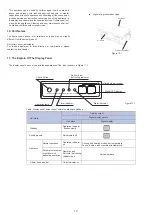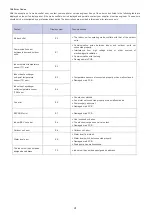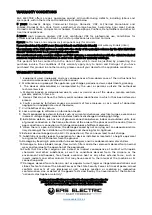
(1) For a water discharge duct connected to the main drain pan in the
indoor unit, the water discharge piping must include a water
storage elbow to prevent loading pressure from building up and
causing poor water drainage, water leaks, or water being
discharged out of the air outlet duct when the indoor unit is running.
(2) In a scenario where the indoor unit runs continuously for long
periods (48 hours or more), continuous operations, or where the
relative humidity of the air is 85% or higher, connect the water
discharge piping of the secondary drain pan to the main water
discharge piping, and then install the water storage elbow. Install
the water storage elbow as shown in Figure 5.3. Install it in such a
way that it is easy to clean.
8. The end of the water discharge pipe must be more than 50 mm
above the ground or from the base of the water discharge slot.
Besides, do not put it in the water.
Figure 5.4 Verify water discharge
Connecting pipes
for water discharge
Water injection from a
hose to a drain pan
Primary
Secondary
Slope of 1/100 or more
0.8 ~ 1.0 m
> 1.0 m
a
b
Figure 5.1
5. Water Discharge Piping Installation
5.1 Water Discharge Piping Installation for Indoor Unit
5.2 Water Discharge Test
5.2.1 Indoor unit without a drainage pump
5.2.2 Indoor unit with a drainage pump
9. Install the water storage elbow.
Figure 5.3 Schematic of water storage elbow
Plug
Note: H should be more than 50 mm.
H
H
Figure 5.2a (without a water pump)
Water discharge pipes from multiple units are connected to the main
water discharge pipe to be discharged through the sewage pipe.
Tilt downwards at 1/100 or more
Figure 5.2b (with a water pump)
Water discharge pipes from multiple units are connected to the main
water discharge pipe to be discharged through the sewage pipe.
Slope of 1/100 or more
1. Use PVC pipes for the water discharge pipes. Based on the
installation scenario, users can purchase the appropriate piping
length from a sales agent, local after-sales service center, or local
market. The piping length should be at least the same length as
the body of the unit.
2. Insert the water discharge pipe into the end of the water suction
connecting pipe of the unit body, and use the ring clamp
(accessory) to clamp the water discharge pipes with the insulation
casing for the water outlet piping securely.
3. Use the insulation casing for water discharge piping (accessory) to
bundle the water suction and discharge pipes of the indoor unit
(especially the indoor portion), and use the tie for the water
discharge piping (accessory) to bind them firmly to make sure air
does not enter and condense.
4. In order to prevent the back-flow of water into the interior of the air
conditioner when the operation stops, the water discharge pipe
should slope downwards towards the outside (drainage side) at a
slope of more than 1/100. Make sure that the water discharge pipe
does not swell or store water; otherwise, it will cause strange
noises. See Figure 5.1.
5. When connecting the water discharge piping, do not use force to
pull the pipes to prevent the water suction pipe connections from
coming loose. At the same time, set a supporting point at every
0.8~1 m to prevent the water discharge pipes from bending. See
Figure 5.1.
6. When connecting to a long water discharge pipe, the connections
must be covered with the insulation casing to prevent the long pipe
from coming loose.
7. Install the water discharge pipes as shown in Figure 5.2a (without
a water pump) and Figure 5.2b (with a water pump). The water
discharge piping outlet should not be higher than the water
discharge height, ensuring a downward slope of more than 1/100.
Caution
•
Make sure all the connections in the piping system are properly
sealed to prevent water leakages.
Before the test, make sure that the water discharge pipeline is
smooth, and check that each connection is sealed properly.
Conduct the water discharge test in the new room before the ceiling is
paved.
(1) Use the water injection pipe to inject about 2000 ml of water into
the drain pan.
(2) Check that the water discharge piping outlet discharge water properly
(based on the length of the pipe, the discharge may occur at a delay
of 1 minute or so), and check for water leakages at each joint.
(1) Use the water injection pipe to inject about 2000 ml of water into
the drain pan.
(2) Connect the power supply, and set the air conditioner to operate
in the cool mode. Check the running sound of the drainage pump,
as well as whether water is properly drained from the water
discharge outlet.
(3) Stop the air conditioner. Wait for three minutes, and then check if
there is anything unusual. If the water discharge piping layout is
not correct, the excessive water flow will cause the water level
error and “EE” error code will be displayed on the display panel.
There may even be water overflowing from the drain pan.
(4) Continue to add water until the alarm for excessive water levels is
triggered. Check if the drainage pump drains water immediately.
After three minutes, if the water level does not fall below the
warning level, the unit will shut down. At this time, you need to turn
off the power supply, and drain away the accumulated water
before you can turn on the unit normally.
(5) Turn off the power supply.
10
Summary of Contents for Gama CND
Page 2: ......
















































